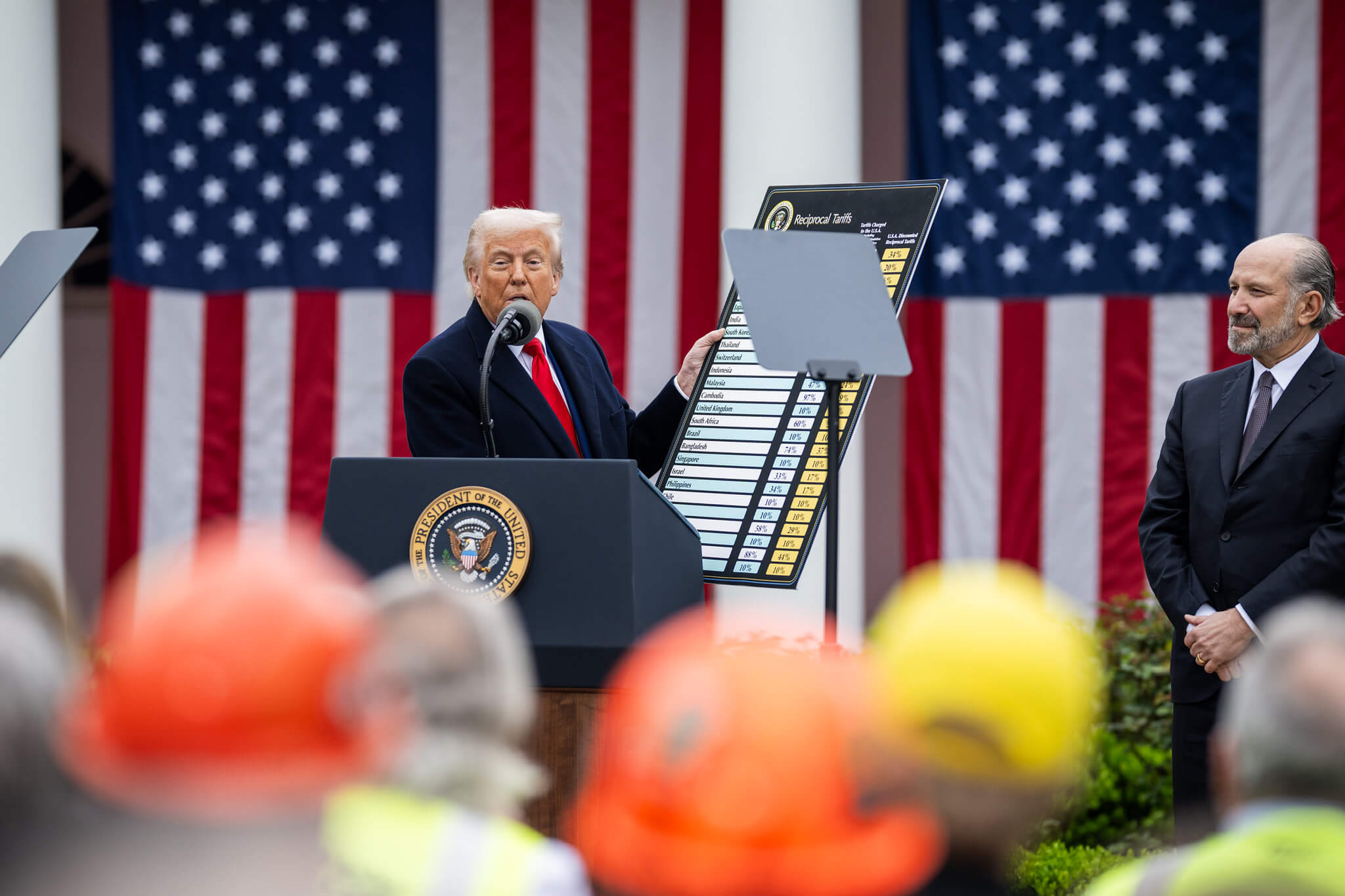Can Congress Reverse Trump's Tariffs?

Published by The Lawfare Institute
in Cooperation With

Editor's note: Shortly after this piece was published, the House of Representatives adopted a resolution “turning off,” through September 30, 2025, the expedited procedures available for a measure terminating the national emergency declared on April 2, 2025 in connection with the imposition of global tariffs.
In the first two and a half months of the Trump administration, trade politics have been front and center. Twice the Trump administration installed tariffs on Canada, China, and Mexico, only to pare them back a few days later following negotiations. Then on Apr. 2—a day he declared “Liberation Day”—President Trump dramatically escalated these efforts by installing unprecedented sanctions against every major trading partner, ranging from a baseline 10 percent tariff to nearly 50 percent in some cases. And so far Trump seems determined to make them stick, warning Americans to “HANG TOUGH” and that “it won’t be easy, but the end result will be historic.”
Financial markets dropped significantly on the news and have largely continued to fall, raising concerns for the broader U.S. economy. Even some of President Trump’s closest allies have begun to question the decision publicly. Less clear, however, is whether anyone will take steps to stop him. While some aggrieved parties have turned to the courts, other aggrieved parties have begun to look to Congress to rein the President in. The simple truth, however, is that, while mechanisms exist for Congress to do so, both political and institutional barriers are likely to make it difficult, at least in the near term.
Article 1, section 8 of the Constitution gives Congress the authority to “lay and collect Taxes, Duties, Imposts and Excises.” Since the 1930s, however, Congress has delegated certain authorities relating to the imposition of tariffs to the executive branch. This dynamic is not unique to trade policy; Congress frequently delegates authority to the president, particularly in foreign affairs, either because the executive branch has more expertise and can act with more expediency or because legislators wish to pass hard choices off to a different branch.
At present, multiple statutory provisions allow the executive branch to impose tariffs. Section 232 of the Trade Expansion Act of 1932, for example, allows the president to impose sanctions after an investigation by the Secretary of Commerce concludes that a given good is being imported “in such quantities or under such circumstances as to threaten to impair the national security[.]” Section 301 of the Trade Act of 1974, meanwhile, allows the U.S. Trade Representative to impose tariffs where he or she determines that “an act, policy, or practice of a foreign country is unreasonable or discriminatory and burdens or restricts United States commerce,” among other related conditions. An array of other so-called “three number” authorities similarly authorize tariffs in response to certain circumstances or following specific findings by senior U.S. officials.
In enacting his most recent tariffs, however, President Trump has largely chosen not to rely on these authorities. Instead, he has used the much more open-ended International Emergency Economic Powers Act (IEEPA), a separate statute more commonly associated with the imposition of economic sanctions that does not have any of the prerequisite process and findings of traditional tariff authorities. IEEPA gives the president broad authority to, inter alia, “regulate…any…transactions involving…any property in which any foreign country or a national thereof has any interest by any person, or with respect to any property, subject to the jurisdiction of the United States[.]” But he may only exercise this authority “to deal with any unusual and extraordinary threat, which has its source in whole or substantial part outside the United States, to the national security, foreign policy, or economy of the United States”—and only then “if the President declares a national emergency with respect to such threat.” Such declarations are in turn regulated by another statute, the National Emergencies Act (NEA), which requires that they be published in the Federal Register and renewed annually, among other requirements.
Consistent with this framework, all of the IEEPA-based tariffs that the Trump administration has imposed have been tied to declared national emergencies. Trump declared the first such emergency on Jan. 20 in relation to “the southern border” and flows of migrants and illegal drugs into the United States. On Feb. 1, he both imposed tariffs on Mexico in relation to this existing national emergency and expanded it to include flows of illegal drugs from Canada and China, whom he also targeted with tariffs. While he quickly suspended many of these tariffs, he reinstated expanded versions against all three countries about a month later on Mar. 3. Then on Apr. 2 he not only ratcheted up tariffs on China under the existing emergency but declared a new national emergency arising from “large and persistent annual U.S. goods trade deficits.” In the same executive order declaring that national emergency, he cited it as grounds for imposing substantial global tariffs against every U.S. trading partner.
No president has previously used IEEPA to impose tariffs in this manner. President Trump considered doing so against Mexico during his first term in office, but ultimately backed off. The only arguable precedent arose during the Nixon administration, which used an almost identically worded predecessor statute to IEEPA to impose a limited set of temporary tariffs on a range of imports in response to a balance of payments crisis—a use that was later upheld by a federal appellate court. But a number of experts have put forward arguments as to why IEEPA may not authorize tariffs of the type and scale the Trump administration is pursuing. Plaintiffs in the Northern District of Florida took up several of these arguments last week in filing the first of what is expected to be several legal challenges to the Trump administration’s actions.
But federal court is not the only avenue through which opponents of the tariffs may be able to secure relief. When Congress enacted the NEA and IEEPA in the late 1970s, they were part of a broader post-Watergate effort to rebalance power between the legislative and executive branches. Like many of the statutes enacted in this period, the NEA included special legislative procedures designed to make it easier for Congress to vote on and potentially enact measures to reverse actions by the president. These expedited procedures usually smooth a measure’s path through one or both chambers by eliminating potential bottlenecks. In the specific case of the NEA, they require that any proposal to terminate a national emergency be reported out of committee within 15 calendar days. The measure then becomes the pending business of the chamber with a vote to follow within three days, unless the chamber decides otherwise at either stage. It also sets out a similarly fixed timeline in the event that the House and Senate pass different versions of the same proposal, giving conferees six days to author a conference report and the two chambers another six days to vote on it. In the Senate, this hard limit on how long the proposal can be considered protects it from a filibuster. Because the chamber is restricted in how long it can debate the resolution, there is no need to invoke cloture, which otherwise requires the support of three-fifths of the Senate to move forward.
As originally enacted, the NEA terminated a national emergency upon passage of a concurrent resolution directing as much, and provided expedited procedures for considering and voting upon any concurrent resolution proposed for that purpose. Since concurrent resolutions only require passage by both chambers—not signature by the president—this effectively gave Congress a veto-proof means of rescinding national emergencies. But in the 1983 matter of Immigration and Naturalization Service v. Chadha, the Supreme Court invalidated a similarly structured mechanism in a different statute on the logic that it created an unconstitutional “legislative veto.” Congress appears to have been convinced that the same logic applied to the NEA’s expedited procedures, as it amended them in 1985 to instead apply to joint resolutions that have the force of law and thus require presentment to (and are subject to potential veto by) the president before becoming law.
This possibility of a veto is a major constraint on the legislative branch’s ability to rescind national emergencies. If the national emergency in question was declared by the sitting president, he or she is unlikely to consent to action rolling it back. And in today’s Congress, securing the two-thirds support in both chambers needed to override a veto is extraordinarily difficult, as it almost always requires votes from members of the sitting president’s own party on an issue he has prioritized.
Nor are even these expedited procedures airtight. The NEA itself notes that its expedited procedure provisions are enacted “as an exercise of the rulemaking power of the Senate and the House of Representatives[,]” which the Constitution vests in each chamber. As a result, each chamber has “the constitutional right…to change the rules (so far as relating to the procedure of that House) at any time, in the same manner, and to the same extent as in the case of any other rule of that House.” This is especially consequential in the House, where, despite being defined in statute, the chamber can alter the procedures’ applicability at any time by a simple majority vote—just as they can with any other rule of the chamber.
Despite these limitations, Congress has periodically used expedited procedures like those in the NEA to push back against national emergency declarations and other actions by the president. During the first Trump administration, both chambers of Congress used the NEA’s expedited procedures to pass not one but two joint resolutions terminating a national emergency relating to the southern border. Congress also used similar procedures in the 1973 War Powers Resolution to pass joint resolutions that sought to terminate U.S. military operations in relation to Iran and Yemen and another set of expedited procedures in the Arms Export Control Act to try and cancel arms sales to Saudi Arabia and Yemen. In each case, however, President Trump ultimately vetoed the resulting joint resolution, which ultimately failed to secure the two-thirds support necessary in both chambers to override his decision.
The likelihood of a presidential veto makes it extremely difficult to actually use expedited procedures such as those in the NEA to countermand presidential actions. But this doesn’t make them meaningless. As the NEA requires committees and the House and Senate to move qualifying proposed joint resolutions forward on a certain timeframe barring disapproval from a majority of a chamber’s members, it allows the sponsors of joint resolutions to force at least one procedural vote on whether to consider opposing the president’s policies. This can compel otherwise reticent legislators to take a public stance on what is often perceived as a referendum on the president’s policies, bringing opposition from within the president's party into the light and creating political space for opposing the president’s policies. In the case of military involvement in Yemen during the first Trump administration, for example, the repeated use of such votes over several years contributed to the development of substantial bipartisan opposition to the Trump administration’s policies in Congress—policies that the Trump administration adjusted in response, though it never fully reversed course.
A similar pattern may be beginning to emerge in the context of President Trump’s IEEPA-based tariffs. Using the NEA’s expedited procedures, a joint resolution to end the national emergency underlying the earlier Canada-specific tariffs recently passed the Senate 51-48 with the support of four Republicans: Susan Collins (R-Maine), Lisa Murkowski (R-Ark.), Mitch McConnell (R-Ky.), and Rand Paul (R-Ky.). Some Republicans in the House have expressed similar skepticism about the tariffs placed on Canadian goods, but their ability to use the NEA’s expedited procedures in their own chamber was limited by a step taken by House leaders last month. As part of a procedural vote to consider, among other measures, the bill to keep discretionary federal programs funded through the end of September, the House adopted a resolution temporarily “turning off” the privileged status for any termination resolution related to the February emergency declaration underlying the Canada tariffs until the end of the year. As a result, rank-and-file House members of either party looking to go around House Republican leadership and force a vote on the resolution do not have the procedurally protected avenue available to them.
The inability to use expedited procedures in the House to vote on a rollback of the national emergency related to the Canada tariffs is not, however, the end of the story. Because the more recent round of global tariffs relies on a different national emergency declaration, House Republican leaders would have to insert a second “turn off” provision into a different procedural resolution to prevent House members from using the NEA’s expedited procedures for joint resolutions to rescind the national emergency underlying those tariffs. And that may be harder to do a second time around.
Ordinarily, one might not expect this to be difficult, as members of the House majority generally vote with their party on these sorts of procedural matters. But the House has struggled to process legislation recently. Its usual approach for bringing most bills to the floor—adopting a resolution known as a special rule that sets the terms of debate on one or more pieces of legislation—got caught in the crosshairs of a dispute over a measure that would allow House members to vote by proxy for a short period after they become parents. Over the past few months, a small group of Republicans, led by Rep. Anna Paulina Luna (R-Fl.), joined with Democrats to get the requisite signatures on a discharge petition that would force a vote on the proxy voting change. Discharge petitions allow 218 House members to force a vote on a measure in the House regardless of whether the Speaker chooses to schedule it for floor consideration. Members of the majority party are often heavily pressured not to sign on to discharge petitions, since they represent a threat to the majority party’s ability to control the floor. But in this case, that pressure doesn’t appear to have been enough.
Opposing Luna’s discharge petition were both House Republican leaders and the House Freedom Caucus, whose members both oppose proxy voting in general (believing it to be unconstitutional) and also appear to want to make it harder for a small group of Republicans to defect from the party on any issue and join a discharge petition with Democrats. The anti-proxy bloc threatened to “shut down the floor” if the speaker didn’t find a way to quash the discharge petition. The pro-proxy group, for its part, went as far as to defeat a procedural motion that would have prevented the discharge petition from coming to the floor—at which point Speaker Johnson sent the House home for the rest of the week to buy time to find a solution.
Luna and House Republican leaders reached a deal to resolve this impasse. But this unrelated floor drama could have spillover consequences for Congress’s ability to act on Trump’s most recent set of tariffs. House Foreign Affairs Committee Ranking Member Gregory Meeks (D-N.Y.) has already announced he plans to file his own discharge petition to bring a measure terminating the national emergency underlying the tariffs against Canada to the floor. That would require the signature of at least five Republicans (and possibly more, if some number of Democrats decline to sign)—a task that could be either easier or harder given other recent developments around the use of discharge petitions. But if Meeks succeeds and the House passes a measure identical to the one adopted by the Senate, then President Trump may soon have to exercise his veto or have his Canada-related national emergency rescinded and related tariffs ended.
In addition, even if House Republicans have removed their proxy voting roadblock to considering procedural motions setting the terms for debate on other bills, adopting language “turning off” the special procedures to terminate the more recent national emergency on which the global tariffs rest could draw opposition from some Republicans. Until the House “turns off” the NEA’s expedited procedures, opponents of Trump’s global tariffs can still use them to force at least one procedural vote on a joint resolution to rescind the underlying national emergency in the House. And if House Democrats remain unified and secure the support of just a handful of Republicans, they might even be able to adopt a joint resolution. Paired with similar action in the Senate—where the same coalition that passed the joint resolution on Canada tariffs may be open to taking a similar step regarding Trump’s global tariffs—this could once again force Trump to exercise his veto or see his global tariffs brought to an end.
Notably, Congress has also been exploring legislative options outside of the context of the NEA to restrain the president’s tariff-related actions. Sens. Chuck Grassley (R-Iowa) and Maria Cantwell (D-Wash.) have proposed legislation under which new tariffs imposed by the executive would expire if not approved by Congress within 60 days. The bill is drawing interest from some other Republicans, but its prospects are dim in chambers controlled by party leaders unlikely to break with President Trump, who has in turn promised a veto. Barring a successful discharge petition, bringing it to the House floor would require the consent of the House Rules Committee—a panel unlikely to buck the president—and of the Speaker of the House. In the Senate, meanwhile, floor action would require either the agreement of the Senate majority leader or a willingness by enough senators to grind the chamber to a halt until the leader brought up the bill; even then, it would need to overcome the threat of a filibuster in the Senate by securing the three-fifths support necessary for cloture.
None of these avenues to relief seem likely in the near term, given the current political landscape. But if Trump’s global tariffs prove damaging and unpopular enough, that landscape may yet change. The NEA’s expedited procedures in turn provide a mechanism by which opponents of Trump’s tariff policies can force a public debate on them, one that may well bring more opposition into the light, including from within his own party, that changes the political dynamics around his actions. In this sense, even if these procedures fail to end Trump’s policies outright, they may help bring about their eventual end.






